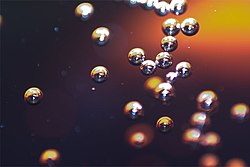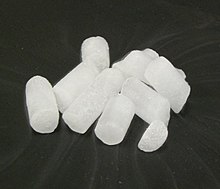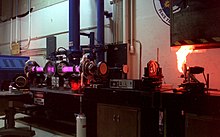Carbon(IV) oxide
Carbon dioxide (chemical formula CO2) is a compound of carbon and Oxygen that exists as a colorless gas at standard temperature and pressure (TPS) conditions. It is closely related to the greenhouse effect.
Prior to the 2005 IUPAC rules, it was also known as carbon dioxide. This chemical compound is composed of a carbon atom bonded with double covalent bonds to two oxygen atoms. CO2 occurs naturally in Earth's atmosphere as a trace gas at a mole fraction of about 400 ppm. The current concentration is about 0.04% (410 ppm) by volume, a 45% higher than pre-industrial levels of 280 ppm. Natural sources include volcanoes, hot springs, geysers, and it is released by carbonate rocks as it dissolves in water and acids. Since CO2 is soluble in water, it occurs naturally in groundwater, rivers, lakes, ice fields, glaciers, and seas. It is present in oil and natural gas deposits.
Atmospheric CO2 is the main source of carbon for life on Earth and its pre-industrial concentration since the late Precambrian was regulated by photosynthetic organisms and geological phenomena. As part of the carbon cycle, plants, algae, and cyanobacteria use solar energy to photosynthesize carbohydrates from CO2 and water, while O2 is released as waste. Plants produce CO2 during nocturnal respiration.
It is a product of the respiration of all aerobic organisms. It returns to the water through the gills of fish and to the air through the lungs of land animals, including humans. CO2 is produced during the processes of decomposition of organic materials and the fermentation of sugars in the manufacture of wine, beer and bread. It is also produced by burning wood (firewood), carbohydrates, and fossil fuels such as coal, peat, oil, and natural gas.
Cellular (mitochondrial) respiration:
Carbon dioxide is an important greenhouse gas. The burning of carbon fuels since the Industrial Revolution has rapidly increased their concentration in the atmosphere, leading to global warming. It is also the main cause of ocean acidification, since it dissolves in the water forming carbonic acid. According to other studies, this is not the case or is irrelevant.
Discovery
Carbon dioxide was one of the first gases to be described as a substance other than breathable air. In the 17th century, the Flemish chemist Jan Baptist van Helmont observed that when coal is burned in a closed container, the resulting mass of the ash was much less than that of the original coal. His interpretation was that the coal was transformed into an invisible substance that he called a "gas" or "wild spirit" (spiritus sylvestre).
The properties of carbon dioxide were further studied in the 1750s by the Scottish physician Joseph Black, who found that limestone (calcium carbonate) when heated or treated with acids produced a colorless gas he called "fixed air.". He observed that fixed air was denser than atmospheric air and that it did not support a combustion flame or animal life. Black also found that by bubbling through an aqueous solution of lime (calcium hydroxide), calcium carbonate would precipitate. This phenomenon was later used to illustrate that carbon dioxide is produced organically by animal respiration and microbial fermentation. In 1772, the English chemist Joseph Priestley published a paper entitled Water Impregnation with Fixed Air in which he described a process of dripping sulfuric acid (or oil of vitriol, as Priestley knew it) onto chalk to produce carbon dioxide, forcing the gas to dissolve; by stirring a bowl of water in contact with the gas, he obtained carbonated water. This was the invention of carbonated water.
Carbon dioxide was first liquefied (at elevated pressures) in 1823 by Humphry Davy and Michael Faraday. The first description of solid carbon dioxide was given by Charles Thilorier, who in 1834 opened a pressure vessel of liquid carbon dioxide, only to discover that the cooling produced by rapid evaporation of the liquid produced "snow" of solid carbon dioxide. (carbonic snow).
In Earth's atmosphere
Scientific studies have determined that the atmospheric content of CO2 has varied through the ages. Indeed, the Devonian period produced a high concentration of atmospheric CO2 above 3000 ppm and a mass extinction was verified 400 million years ago and on the other hand in the Jurassic period (150 million years ago). million years) levels exceeded 1700 ppm in that era against 290-390 ppm in the recent industrial period, the high presence has been related to intense volcanism and high ambient temperatures in those periods.
Carbon dioxide in Earth's atmosphere is a trace gas, currently (2018) with a concentration of 407.8 parts per million by volume. Atmospheric concentrations of CO2 fluctuate slightly with the change of seasons. Concentrations drop during the northern hemisphere spring and summer as plants consume the gas; and increase during the northern fall and winter as plants go dormant or die and decay. Concentrations also vary regionally, strongest near the ground with much smaller variations high up. In urban areas concentrations are generally higher and inside homes concentrations of 10 times the ambient level can be reached.
The burning of fossil fuels and deforestation have led to an increase in atmospheric CO2 concentration of close to 43% since the beginning of the industrialization era. Most of the carbon dioxide Carbon from human activities is released by burning coal and other fossil fuels. Other human activities such as deforestation, biomass burning and cement production also produce CO2. Volcanoes emit between 0.2 and 0.3 billion tons of CO2 per year, compared to about 29 billion tons per year of CO2 > emitted by human activities. Up to 40% of the gases emitted by some subaerial erupting volcanoes is carbon dioxide.
Greenhouse effect
Carbon dioxide is a greenhouse gas, which absorbs and emits infrared radiation at its two infrared-active vibration frequencies. This process causes carbon dioxide to warm the surface and lower atmosphere and cool the upper atmosphere. A large majority of climatologists agree that the increase in the atmospheric concentration of CO2, and therefore in the greenhouse effect induced by CO2, is the main reason for the increase in global average temperature since the middle of the XX century. Although the main greenhouse gas responsible for warming is carbon dioxide, methane, nitrous oxide, ozone, and other long-lived greenhouse gases also contribute. CO2 is of most concern, as it exerts a greater global warming influence than all other gases combined, and because it has a long atmospheric lifetime.
Not only do rising CO2 concentrations lead to increases in the planet's surface temperature, but rising global temperatures also cause rising CO2. This produces a positive feedback to the changes induced by other processes, such as orbital cycles. Half a billion years ago the concentration of carbon dioxide was 20 times higher than today, it decreased to 4-5 times during the Jurassic period and then it declined slowly with a particularly rapid decline occurring 49 million years ago.
Local concentrations of carbon dioxide can reach high values near strong sources, especially those that are isolated by the surrounding terrain. In the Bossoleto hot springs near Rapolano Terme in Tuscany, Italy, situated in a bowl-shaped depression approximately 100 m in diameter, CO2 concentrations rise by more than 75% during night, enough to kill insects and small animals. After sunrise the gas disperses by convection during the day. High CO2 emissions to the air—produced by the disturbance of deep lake water, saturated with CO2 >— believed to have caused 37 deaths in Lake Monoun (Cameroon) in 1984 and 1,700 victims in Lake Nyos (Cameroon) in 1986.
Carbon dioxide in the space environment
Carbon dioxide is also present on other planets in the solar system.
In the Solar System, there are two nearby examples of rocky planets with carbon dioxide atmospheres:
- Venus with 96.5 % carbon dioxide that presents an extreme greenhouse effect picture because the gaseous layers of this gas combined with sulfuric acid heat the atmosphere under pressure of 94 terrestrial atmospheres creating a surface temperature of hundreds of degrees Celsius.
- Mars, its tenuous atmosphere contains more than 95.3 % of this gaseous compound and due to its low temperatures it is present as a solid in its polar caps. In the case of Mars, it does not have a greenhouse effect since its tenuous atmosphere with low atmospheric pressure may prevent the hydrodynamic sustainability of this gas, however, its presence is very high (95.3 %).
Industrial use
It is used as an extinguishing agent, eliminating the oxygen found in that space, and preventing combustion from being generated.
In the food industry, it is used in carbonated drinks to give them fizz.
It can also be used as a harmless or slightly polluting acid. Acidity can help to curdle dairy products in a faster and therefore cheaper way, without adding any flavor, and in the industry it can be used to neutralize alkaline residues without adding another more polluting acid such as sulfuric.
In agriculture, it can be used as fertilizer. Although plants cannot take it up through the roots, it can be added to lower pH, prevent lime deposits, and make some soil nutrients more available.
It is used in greenhouses and indoor crops to increase CO2 in the environment through combustion (propane or natural gas) or injection of pure liquid CO2 and achieve an increase of the harvest.
Also in refrigeration it is used as a kind of coolant in refrigerating machines or frozen as dry ice. This same compound is used to create artificial fog and the appearance of boiling water in special effects in movies and shows.
Another use that is increasing is as an extracting agent when it is in supercritical conditions, given its little or no residue in the extracts. This use is currently reduced to obtaining alkaloids such as caffeine and certain pigments, but a small review by scientific journals can give a vision of the enormous potential that this extraction agent presents, since it allows extractions to be carried out in anoxide media, which allows obtain products with high antioxidant potential. The critical temperature and pressure of carbon dioxide can be changed by adding other substances known as doping fluids, which is useful for certain applications, such as its use in thermodynamic cycles for electricity generation. The combination of CO2 with such fluids is called a supercritical carbon dioxide mixture.
It is also used as an active material to generate coherent light (CO2 laser).
Along with water, it is the most widely used solvent in processes with supercritical fluids.
Carbon dioxide is an unwanted by-product in many large-scale chemical processes, such as the selective oxidation of hydrocarbons to oxygenates. Carbon dioxide is the thermodynamically favored product in each oxidation reaction. Therefore, the challenge in the development of these processes is to find a suitable catalyst and process conditions that allow the production of the thermodynamically less favored target product and minimize the production of carbon dioxide.
Medical use of carbon dioxide
- As an insufficiency agent in laparoscopic surgeries.
- As a contrast agent in blood vessel radiology.
- In CO laser2.
- As an agent for mechanical ventilation in surgeries.
- In treatment of cranial wounds and acute and chronic ulcers.
- In aesthetic treatments.
- In the treatment of circulatory problems.
Oxygen source
The Perseverance rover carried to Mars a module called the MOXIE – Mars Oxygen ISRU Experiment, a device of in situ resource utilization to produce oxygen from the carbon dioxide atmosphere of Mars (Principal Investigator: Michael Hecht, Massachusetts Institute of Technology, Cambridge, Massachusetts). This technology based on electrolysis could be considered in the future to sustain human life or make rocket fuel for return missions. MOXIE succeeded in producing oxygen from Martian atmospheric CO2 on a small scale. Below is the net reaction:
- 2CO
2 Δ Δ {displaystyle longrightarrow } 2CO + O
2
- 2CO
Detection and quantification
Carbon dioxide can be qualitatively detected in the gas form by reaction with barite water (Ba(OH)2) with which it reacts to form barium carbonate, an insoluble white precipitate in excess of reagent but soluble in acidic solutions. The quantification of carbon dioxide is done by acid-base methods indirectly and by instrumental methods using infrared.
Contenido relacionado
Marine sedimentary media
Electronegativity
Drug







